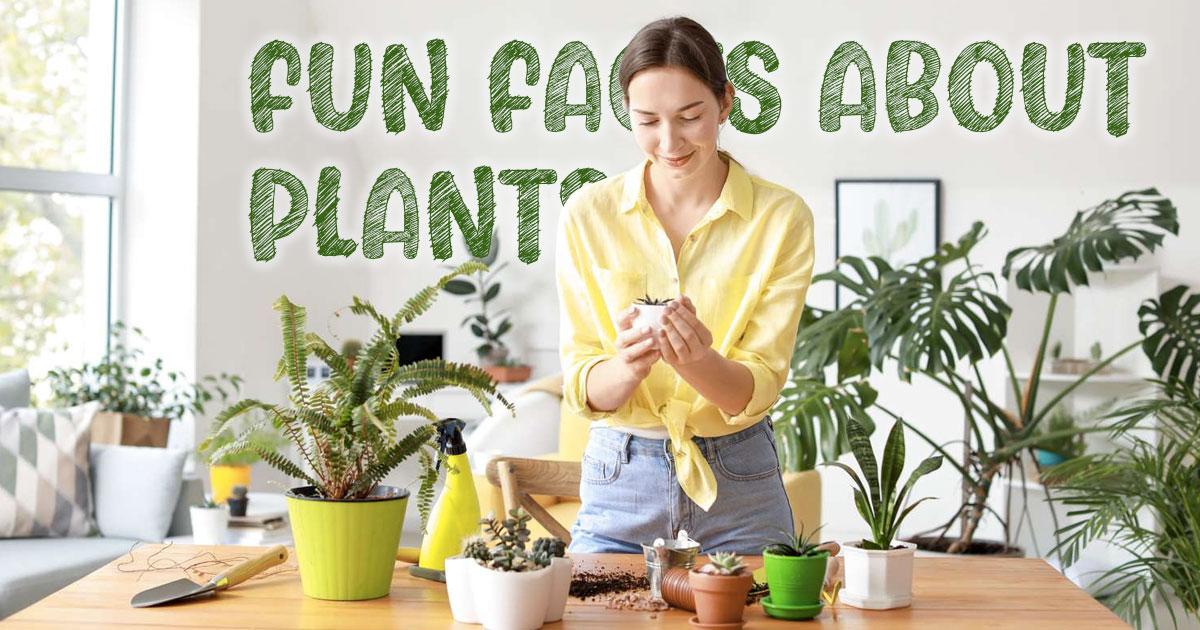Fun Facts About Plants – Discover the Fascinating World of Botanical Marvels

Welcome to the enchanting world of plants! Whether you’ve been a passionate plant parent for a long time or are just starting out, these interesting fun facts about plants will catch your attention. From their extraordinary adaptations to their intriguing behaviors, plants have many secrets to share.
This article looks at 15 interesting and fun facts about plants. These facts will help you understand the wonders of the plant world better. So, grab your watering can and gardening gloves and prepare for a fun trip through the amazing world of plants.
1. Plants Communicate and Respond
Plants have an amazing ability to talk to each other and react to their surroundings. They can warn nearby plants through chemical signals and electrical impulses about impending threats, such as insect attacks. This unique communication system, known as allelopathy, helps them defend themselves and ensure their survival. Scientists have also discovered that plants emit volatile organic compounds (VOCs) to communicate with beneficial insects, attracting them to help ward off pests.
2. Plants Can Recognize Their Relatives
Plants have a unique way of recognizing their kin. By releasing chemicals into the soil, they can identify their siblings and allocate resources accordingly. This “family-first” approach showcases the intricate social dynamics within plant communities. Research has shown that related plants will give more resources to their kin, enhancing their overall growth and survival.
3. Some Plants Are Carnivorous
While most plants rely on photosynthesis for sustenance, some have evolved to become carnivorous. They trap and consume insects to supplement their nutrient intake, making them the ultimate green predators. Interesting examples include the pitcher plant, which uses a unique leaf structure to trap insects, and the Venus flytrap, which closes when tiny hairs on its leaves trigger it.
4. Orchids Have an Incredibly Diverse Family
Orchids are one of the most well-known flowering plants, with more than 30,000 known types. Beautiful orchids come in stunning colors, shapes, and sizes, captivating both seasoned horticulturists and amateur plant parents alike. From the rare Ghost Orchid to the flamboyant Lady’s Slipper, orchids offer a treasure trove of floral beauty and diversity.
5. Plants Can “Smell”
Although plants lack noses, they can sense and respond to certain odors. For example, the aroma emitted by damaged leaves triggers nearby plants to produce chemical compounds that make them less appetizing to insects. This unique defense mechanism helps ensure their survival. Additionally, certain flowers release fragrances to attract pollinators, utilizing scent to communicate and reproduce.
6. The Oldest Living Plant is Over 9,000 Years Old
The oldest living thing in Utah is the Pando, a huge group of quaking aspen trees. Estimates suggest that this interconnected grove of genetically identical trees is over 80,000 years old, making it a true natural wonder. Each tree in Pando is a clone of the others, connected by a single massive underground root system.
7. Plants Influence the Weather
Forests are very important for keeping the weather in balance. Through a process known as transpiration, plants release moisture into the atmosphere, which in turn affects local humidity, precipitation, and temperature. They act as nature’s air conditioners and rainfall regulators, creating microclimates and influencing regional weather systems.
8. The Tallest Plant in the World
The majestic coast redwood (Sequoia sempervirens) is the tallest plant species on Earth. These towering giants can reach staggering heights of over 350 feet (107 meters), inspiring awe and admiration among all who encounter them. Some redwoods are known to be more than 2,200 years old, standing as living witnesses to history.
9. Plants Can “Remember” & Learn
Contrary to popular belief, plants have a form of memory and learning ability. They can remember and respond to past experiences, allowing them to adapt their growth patterns and behavior accordingly. This remarkable adaptability ensures their survival in ever-changing environments. Studies have shown that plants can learn from exposure to stimuli, such as sound or touch, and adjust their growth and defense mechanisms accordingly.
10. Sunflowers Track the Sun
Sunflowers possess a unique behavior called heliotropism, which means they track the sun’s movement across the sky. From dawn till dusk, sunflowers orient themselves to face the sun, maximizing their exposure to sunlight for optimal photosynthesis. This behavior is most prominent in young sunflowers and helps them maximize their growth potential.
11. The Largest Flower in the World
The Rafflesia arnoldii holds the title of the world’s largest flower. This huge flower grows in Southeast Asia and can get up to three feet (one meter) across and weigh 11 kilograms (24 pounds). Its pungent smell, resembling rotting flesh, attracts pollinators such as flies. The flower has no leaves, stems, or roots and is entirely parasitic, relying on its host plant for nutrients.
12. Plants Have Healing Powers
For thousands of years, people have used plants as medicines. Many modern medicines, including painkillers and antibiotics, are derived from plants. Examples include the willow tree (source of aspirin) and the foxglove plant (source of digitalis), used to treat heart conditions. The study of medicinal plants, known as ethnobotany, continues to uncover the healing potential of various plant species.
13. Plants Can “See” and Sense Gravity
Plants possess a remarkable ability called gravitropism, allowing them to sense and respond to gravity. Roots grow downwards, while shoots grow upwards, ensuring that plants are oriented correctly about the Earth’s gravitational pull. Specialized cells containing tiny starch grains known as statoliths, which settle in response to gravity and aid the plant in determining its orientation, control this response.
14. Bamboo: Nature’s Marvel
Bamboo is an incredible plant with countless practical uses. It is one of the fastest-growing plants on Earth, capable of growing up to 35 inches (91 centimeters) in a single day. It is a valuable resource in many businesses because it is strong, flexible, and long-lasting. From construction and furniture-making to textiles and even as a renewable energy source, bamboo amazes us with its remarkable properties.
15. Plants Improve Indoor Air Quality
Are you looking for houseplant facts? Houseplants add beauty to our living spaces and improve indoor air quality. They take in carbon dioxide and give off oxygen. At the same time, they clean the air by getting rid of harmful chemicals like formaldehyde and benzene. Studies have shown that having plants inside can help you feel less stressed, be more productive, and be healthier overall. Becoming a plant parent brings joy and provides tangible benefits for your health and the environment.
Some flowers, like aloe vera and snake plants, give off oxygen at night in addition to cleaning the air. This makes them perfect for the bedroom. They can help improve sleep quality by increasing oxygen levels and reducing airborne pollutants, creating a more peaceful and rejuvenating atmosphere.
An Exciting Journey as Plant Parents
Furthermore, caring for plants, commonly known as plant parenthood, can be a rewarding and therapeutic experience. Nurturing plants allows us to connect with nature, reduce stress, and instill responsibility. The bond formed between plant parents and their leafy companions is a special one, as we witness the growth and flourishing of these living organisms under our care.
Plant parenthood has also become an eco-friendly trend, with many individuals creating green spaces within their homes. Urban gardening and vertical plant walls are becoming increasingly prevalent, allowing people to maximize their living spaces while reconnecting with nature. These green oases are beautiful to look at and they help make the world a healthier and more sustainable place to live.
In plant parenthood, enthusiasts share their experiences, tips, and knowledge through various platforms, such as social media, blogs, and online communities. The exchange of ideas and expertise has fostered a vibrant and supportive community where plant lovers can connect, seek advice, and celebrate their shared passion. This thriving community has contributed to the resurgence of interest in plants and has inspired many individuals to embark on their green journeys.
Discover more amazing and fun facts about plants!
As we learn more about plants, we find a huge number of species, each with its own special traits and ways of adapting. Succulent plants store water in their leaves to live in dry places, and carnivorous plants have evolved to do well in areas that don’t have many nutrients. The variety of plant life is always amazing.
These amazing living things talk to each other, change, heal, and make our lives better in a huge number of ways. Plants are very important to our health and the future of our world. They have complex social structures within plant groups and clean up the air we breathe. So, whether you’ve been taking care of plants for a long time or this is your first time, get lost in the fascinating world of plants. Enjoy the pleasure of taking care of these green friends and know that you are making the world a better, happier, and more peaceful place.

